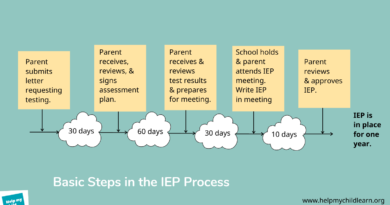What Should I Know about Laws That Protect Learning: 504 and IEP?
There are two laws that are always mentioned when people talk about getting support from the educational system:
The Section 504 Civil Rights Law
Section 504 of the Rehabilitation Act of 1973 is a civil rights law that protects people with disabilities from discrimination. Section 504 ensures that a child with a disability has equal access to education, and provides accommodations and/or modifications to normal schoolwork.
Section 504 defines “disability” broadly, and can help children with learning and attention issues succeed in a general education classroom. When your child qualifies for services under this act, your child is said to have a 504 plan. A 504 plan is often used for children who need more time on tests, hearing support, scribing help (taking dictation), a keyboard, or other accommodations.
Here’s more information on Section 504, and a list of resources.
The Individuals with Disabilities Education Act (IDEA)
The Individuals with Disabilities Education Act, or IDEA, was enacted by Congress in 1975 to ensure that all children have the opportunity to receive a free and appropriate public education, regardless of ability. IDEA provides for most of the protection for children with learning disabilities, and laws in IDEA spell out the basic tool of special education: the Independent Education Program, or IEP.
When your child qualifies for services under IDEA, your child is said to have an IEP. IEPs are supported by the special education department, and typically, children with an IEP require at least some support from a teacher with a special education credential.
What Do You Need to Know To Get Help?
A lot of the time, people make you sit through a big description of how the law works, and in what way people disagree about the law, before they tell you how to actually get help for your child.
We don’t do that. Here are the things you need to know.
- Before you start, we suggest that you read this post, which describes the difference between an IEP, a 504, and the RTI program used by some schools.
- And here’s a very simple overview and explanation of how to to get an IEP for your child.
- Note: Applying for the IEP is a legal process. You have to do actions in order. The IEP provides for a full evaluation at no cost for your child. We actually suggest that, even if you think your child needs a 504, that you apply for IEP testing.
- If you really only want a 504, then you can get one by having a doctor write a note as we describe in this post.
It’s important that you understand that the basic processes to apply aren’t very complex. Disagreements may happen, as we describe in this post, talking about IEP disagreements, but we point you to wonderful resources who can help you.
Every State has Resources Set up to Help You Understand the Law and Apply for LD Support
This website lists parent training centers for every state. You can also search for [your state name] IEP Advice to find state-specific information. For example, here’s a California Department of Education website that we get if we search for California IEP Advice.
Remember that each state can have their own legal variations, so it’s good to find out what your state requires. This diagram by Understood explains the difference between Federal and State special education support laws.
To see resources that, by law, your state is required to provide, simply type the following into your internet search engine: State name IEP help. For example, typing:
Minnesota IEP help
will return a list of help resources about getting an IEP in Minnesota.
Our Favorite Resources
Our favorite resources are the Wrightslaw website, and the Understood website.










Pingback: Yes, but How do I Apply for an IEP? - Help My Child Learn
Pingback: How Do I Apply for a 504 - Help My Child Learn